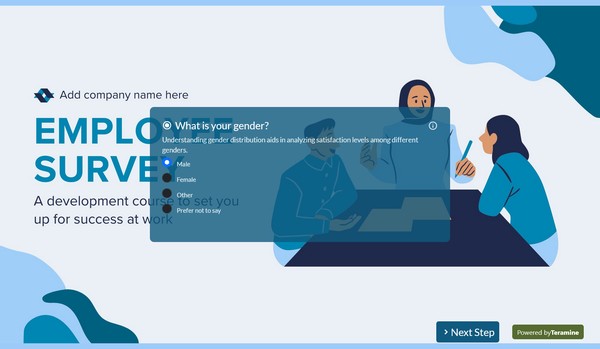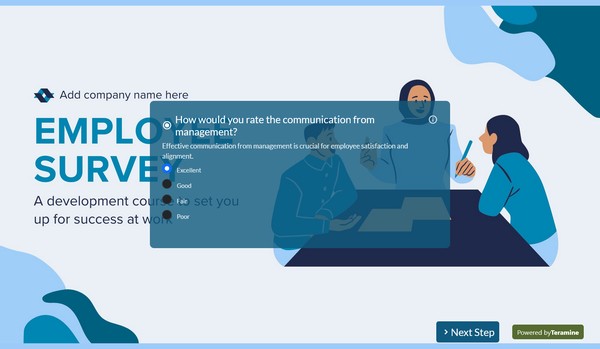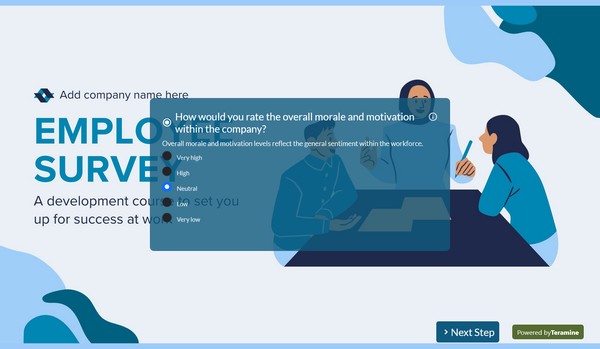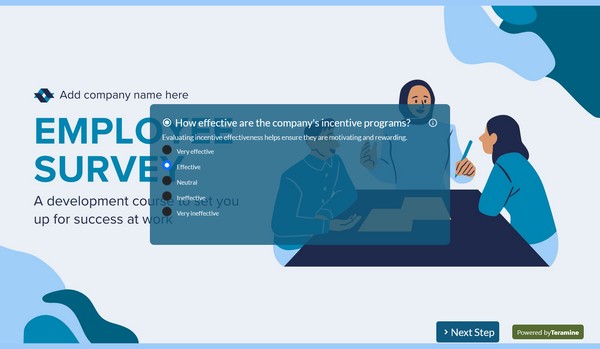Employee Satisfaction Survey

An Employee Satisfaction Survey should be meticulously designed to comprehensively capture the sentiments, attitudes, and opinions of the workforce. It should encompass various dimensions that collectively contribute to employee satisfaction. This structured approach ensures that the survey comprehensively addresses all factors impacting employee satisfaction, thereby providing valuable insights which can drive meaningful organizational improvements.






























Employee Satisfaction Survey FAQs
An Employee Satisfaction Survey is a systematic tool used by organizations to assess the overall contentment and engagement levels of their workforce. This survey typically gathers feedback on various aspects of the employee experience, including job satisfaction, workplace culture, management practices, communication, and opportunities for professional development.
The primary objectives of conducting an Employee Satisfaction Survey include:
Identifying Areas for Improvement: By understanding employees' sentiments, organizations can pinpoint specific areas that may require enhancement, thereby fostering a more conducive work environment.
Enhancing Employee Engagement: Feedback from the survey can guide leadership in developing strategies that align with employee expectations and aspirations, ultimately increasing engagement levels.
Retention Strategies: Insights garnered from the survey can inform retention strategies, as understanding the factors contributing to employee satisfaction can help organizations reduce turnover rates.
Benchmarking Performance: Regularly conducting these surveys allows organizations to track changes in employee satisfaction over time, facilitating comparisons to industry standards or internal benchmarks.
Facilitating Open Communication: The survey serves as a platform for employees to express their opinions anonymously, promoting a culture of openness and trust.
Organizations typically distribute these surveys periodically—annually or semi-annually—utilizing various formats, including online questionnaires, focus groups, or one-on-one interviews. The analysis of the collected data enables management to make informed decisions that contribute to a positive organizational climate and enhance overall employee well-being.
An Employee Satisfaction Survey is an essential tool for organizations seeking to understand and enhance employee engagement and overall workplace morale. A well-structured survey typically includes the following key components:
Demographic Information: Collecting basic data such as department, tenure, and role can help in analyzing trends and satisfaction levels across different groups within the organization.
Work Environment:
- Assessment of physical workspace conditions (e.g., cleanliness, safety, comfort).
- Evaluation of remote work conditions if applicable (e.g., technology access, work-life balance).
Job Satisfaction:
- Questions regarding the clarity of job roles and responsibilities.
- Satisfaction with work-life balance.
- Sense of purpose and fulfillment in daily tasks.
Management and Leadership:
- Evaluation of managerial support and communication styles.
- Assessment of leadership's effectiveness in providing direction and feedback.
Career Development:
- Opportunities for professional growth and advancement within the organization.
- Availability and access to training and development programs.
Communication:
- Effectiveness of internal communication channels.
- Openness to feedback and suggestions from employees.
Compensation and Benefits:
- Satisfaction with salary, bonuses, and overall compensation structure.
- Evaluation of benefits such as health insurance, retirement plans, and other perks.
Company Culture:
- Assessing the overall organizational culture and values.
- Sense of belonging and inclusion within the workplace.
Recognition and Reward:
- Opportunities for recognizing employee contributions and achievements.
- Feedback on the effectiveness of current recognition programs.
Open-Ended Questions:
- Space for employees to provide additional thoughts, suggestions, or concerns can yield valuable qualitative insights.
- Overall Job Experience:
- General satisfaction with working at the company and likelihood of recommending it as a workplace to others.
- Action Items:
- Questions regarding what improvements employees would like to see implemented.
For optimal results, ensure questions are clear and concise, and consider utilizing a mix of quantitative (e.g., Likert scale) and qualitative (open-ended) question formats. Additionally, anonymous participation can foster honesty and encourage more candid feedback from employees. This comprehensive approach will not only measure satisfaction levels, but also aid in identifying areas for improvement within the organization.
Utilizing an Employee Satisfaction Survey offers multiple benefits that can significantly enhance organizational performance and employee engagement. Here are some key advantages:
Enhanced Communication: Surveys provide a structured forum for employees to express their thoughts and feelings about their work environment, fostering a culture of open communication.
Identifying Areas for Improvement: By assessing employee sentiment, organizations can pinpoint specific areas needing attention, allowing for targeted interventions to enhance workplace conditions.
Increased Employee Engagement: When employees feel their opinions are valued, their engagement levels often rise. This can lead to enhanced productivity and commitment to organizational goals.
Informed Decision-Making: Data gathered from surveys enables management to make evidence-based decisions regarding policies, benefits, and workplace culture, aligning them more closely with employee needs.
Retention and Recruitment: Understanding employee satisfaction can help reduce turnover rates and attract top talent, as prospective candidates are often drawn to companies with a high level of employee contentment.
Measuring Organizational Culture: Surveys can serve as a valuable tool for assessing the health of the organizational culture, identifying strengths and weaknesses that can either support or hinder business objectives.
Benchmarking: Regularly conducting employee satisfaction surveys allows organizations to benchmark their results over time or against industry standards, facilitating strategic planning and continuous improvement.
Boosting Morale: Addressing concerns raised in surveys can lead to immediate improvements, boosting overall employee morale and contributing to a positive workplace atmosphere.
Alignment with Business Goals: By aligning employee satisfaction metrics with strategic objectives, organizations can foster a more cohesive workforce that is committed to achieving corporate goals.
Enhanced Performance Management: The insights gained can inform performance management approaches and help identify training and development needs, ultimately enhancing individual and team performance.
In summary, conducting an Employee Satisfaction Survey is a strategic investment in human capital that can yield substantial returns in terms of employee well-being and organizational effectiveness.




























